-
"Ji" is a plaster like substance used by traditional makers in Japan to work up the interior of a shakuhachi. The word Jiari translates to "Ji exists", sometimes these same flutes are referred to as Jinuri shakuhachi, meaning "painted or smeared with ji". Unlike a Western silver concert flute, the inside of bamboo is not a smooth tube, it has many irregularities. Coating the bore of the bamboo with Ji provides the ability to create a smooth surface.

- bore of a red pigmented jiari shakuhachi
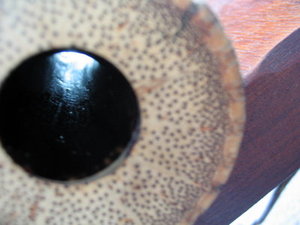
- bore of a black pigmented jiari shakuhachi
The lack of irregularities allows the shakuhachi maker to predictably craft an instrument that will meet the demands of modern shakuhachi players.
-
The word Jinashi translates to "without Ji" however it often is used to describe a natural bore flute with only a little Ji added. Jinashi shakuhachi take advantage of the complex tone created by the irregularities of the natural bamboo. For a good jinashi instrument, the maker works with the resonance points within the bore by either taking some material away or adding a very small amount of ji until the shakuhachi plays as well as possible.
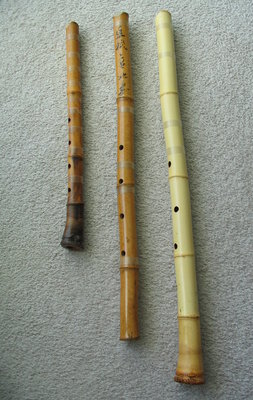
- three jinashi shakuhachi: a 1.8, a hocchiku, and a Taimu 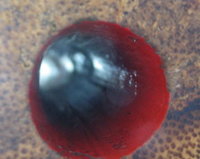
- bore of a painted jinashi shakuhachi 
- bore of an unpainted jinashi shakuhachi (Taimu) There are a relatively small number of shakuhachi makers who offer high quality Jinashi shakuhachi.
-
The term Jimori, translating to "a serving of ji" is often used to describe a shakuhachi where there is ji, but not enough to build up the entire bore. Eg., the interior nodes of the bamboo may be visible.
-

A Hocchiku refers to a construction that consists of a very raw piece of bamboo. Hocchiku sometimes do not include the root-end of the bamboo, similar to the Japanese hocchiku in the image to the left, however hocchiku usually do include the root-end. Hocchiku very seldom have a bore coated with lacquer as is common with other jinashi shakuhachi. Hocchiku typically have a natural mouthpiece, or utaguchi, without the inlay found in other jinashi shakuhachi.
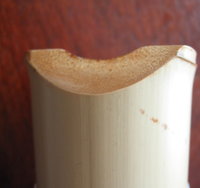
-Natural utaguchi -
The mouthpiece, or utaguchi, inlays can also differentiate shakuhachi. Since kinko and tozan are two different schools, it can sometimes be an indication that the instrument will have been constructed to be favorable to playing the music of that style, particularly with older shakuhachi. There are several other mouthpiece styles, however Tozan and Kinko are the most common.
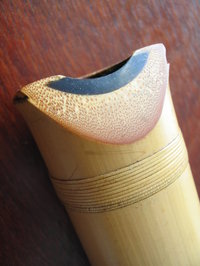
- Tozan utaguchi 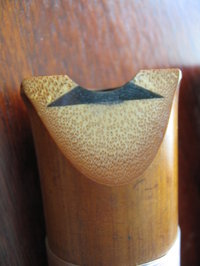
- Kinko utaguchi -
Shakuhachi normally have 5 holes, 4 holes in the front and 1 thumb hole. Seven hole shakuhachi have two additional holes, one that is covered and uncovered by the little finger of the bottom hand, and one that is covered and uncovered by the middle finger of the top hand. The extra holes on a seven hole shakuhachi allow access with the fingers to notes that are obtained on a five hole shakuhachi by changing the angle between the shakuhachi and the head, a difficult technique that produces a quieter tone than the other notes on the shakuhachi. The difference in tone for these notes on a five hole shakuhachi is desirable for some shakuhachi repertoire, including honkyoku. Since those notes have a more even tone on a seven hole shakuhachi, seven hole shakuhachi are not used often for Japanese traditional music.

- The arrows in this image point to the extra holes -
Differences in the length of shakuhachi change the character of the instrument dramatically. Despite that the name shakuhachi is derived from the shaku system of measurement and describes an instrument one shaku and hachi (or "eight") sun long, different length shakuhachi are common. The standard length is 1.8, and teachers use the standard length shakuhachi when teaching. However, many people are drawn to the lower tones of longer shakuhachi. At advanced levels there are pieces that are typically played on longer instruments and ensemble pieces that sometimes require lengths other than 1.8. Longer shakuhachi play lower pitches than the standard 1.8 shakuhachi. In general, each additional "sun" in length lowers the pitch by one semi-tone. A standard 1.8 shakuhachi's lowest note has a pitch the same as a Western "D". A 1.9 shakuhachi will typically have "C#" as the lowest note, and a 2.0 will sound a "C" as the lowest note. Differences in bore size and profile can change this length/pitch relationship by a significant amount, and is something that needs to be taken into consideration when selecting a shakuhachi.
-
Most jiari and some jinashi shakuhachi have a "nakatsuki", a joint that allows the shakuhachi to be taken apart.
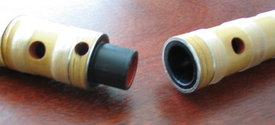
- a nakatsuki Most jinashi and some jiari or jimori shakuhachi are "nobekan", meaning that they are one piece with no joint to allow them to be taken apart. The nakatsuki makes it easier for the shakuhachi maker to access the bore of the shakuhachi to coat it with ji, and is the primary reason most jiari shakuhachi have a nakatsuki. The nakatsuki also gives the maker more freedom in selection of bamboo to make the shakuhachi from. Whether or not a shakuhachi has a nakatsuki bears little importance on tonal quality when the joint has a snug fit. However, since it is the only moving part on the shakuhachi it is prone to being damaged and is a common source of air leakage.

- a nobekan shakuhachi
The above list is not comprehensive, but are the most common distinctions that are made between different shakuhachi.
